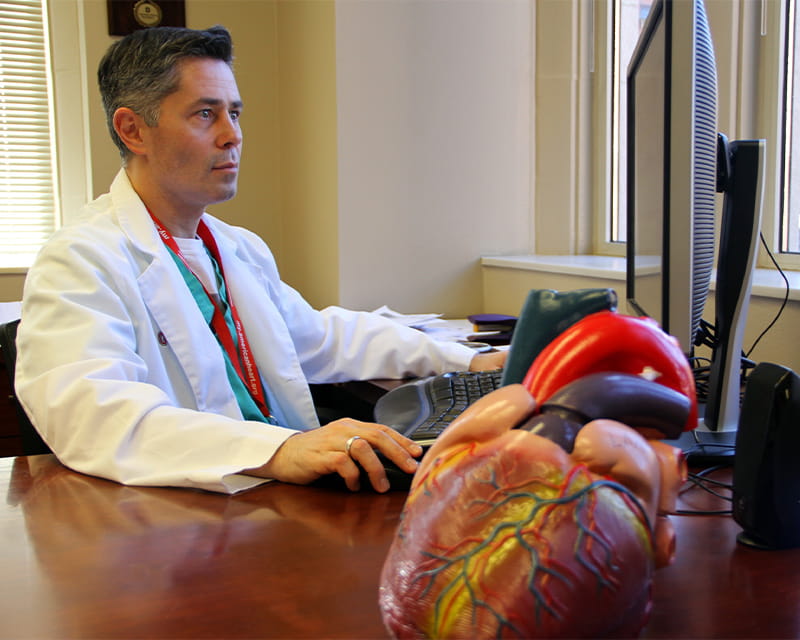
Safer Patient Transport

Clinicians at Ross Heart Hospital are already familiar with the benefits of subspecialty palliative care. Nearly a decade ago, the nationally ranked hospital launched its inpatient palliative care service for people with serious cardiovascular conditions including heart failure and pulmonary hypertension.
However, the program’s 2018 expansion — which includes in-person and telehealth consultations two full days per week — has further strengthened the collaboration between the cardiovascular and palliative medicine teams.
“We knew the outpatient clinic would allow more patients access to palliative medicine services,” says Todd Barrett, MD, MBA, medical director of palliative medicine at Ross Heart Hospital. “But we’re also providing extra resources to the providers. We’re helping cardiologists and surgeons focus more of their attention on patients’ cardiovascular needs, and spend less time managing difficult symptoms or tough conversations about advance care planning.”
A 2019 survey of Ross Heart Hospital providers found that:
“Our cardiovascular specialists appreciate having partners they trust to hold critical and time-consuming conversations with the sickest of our sick patients,” says Dr. Barrett. “And they value having colleagues who can help oversee complex symptom management. Together we’ve led an important culture shift that has produced genuine patient-centered care.”
At the Ross Heart Hospital, subspecialty palliative medicine physicians like Dr. Barrett offer patients and their families extra care and support, often on top of life-prolonging treatments. Services are based on individual needs, and may include:
These opportunities to optimize care have increased since the cardiac palliative care team opened its new clinic a year ago.
“In our first 12 months, we’ve provided outpatient palliative care consultations to 175 new cardiovascular patients,” says Dr. Barrett. “Not only are we measurably improving their quality of life, data shows we’ve reduced readmission rates and have lowered the costs of their care. Equally important, among our patients with end-stage disease, most are dying in the location of their choice.”
In the United States, a staggering number of people are living with debilitating symptoms caused by chronic, progressive cardiovascular conditions. In just three years, from 2013 to 2016, 6.2 million Americans developed heart failure.
“Symptoms take a toll on patients’ physical and emotional health, and often place significant caregiving demands on family members,” explains Dr. Barrett. “For example, about 60% of people with heart failure have significant pain and 40% suffer from depression. It’s also hard to estimate prognosis, meaning patients and their loved ones face multiple, complex choices about pursuing or continuing treatments.”
Dr. Barrett says despite these challenges, introducing palliative care at the earliest possible stage of their illness can profoundly impact quality of life.
“We provide symptom- and stress relief across the entire trajectory of illness and ensure treatments align with our patients’ values and goals,” he adds.
Dr. Barrett says he’s proud to be part of a team that is at the forefront of subspecialty palliative care.
“We’re talking between teams, we’re putting patients and families in the driver’s seat and we’re better equipped to care for people across all stages of heart disease,” he explains. “Not only is this level of care unique for a heart hospital, it’s unique among most hospitals."
A report published by The Center to Advance Palliative Care found that in 2015, an average 4.8% of U.S. hospital admissions received palliative care. This rate, known as palliative care service penetration, was nearly 80% higher than in 2009 — a sign that general hospital palliative care is growing.
“In comparison, our palliative care service penetration at Ross Heart Hospital exceeds 8%,” says Dr. Barrett. “This puts us above the median in the top quartile of hospitals nationwide and shows that our patients and their families have exceptional access to life-changing palliative medicine.”
Read more featured stories about The Ohio State University Heart and Vascular Center.

Safer Patient Transport

New treatment for atrial fibrillation

First US Medical Center in Clinical Trial